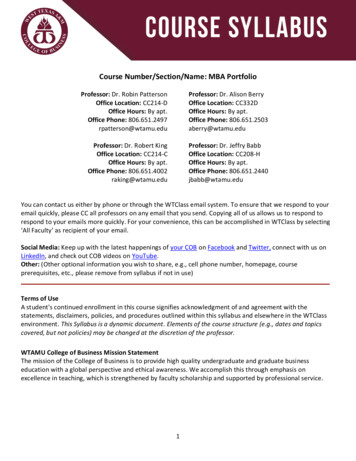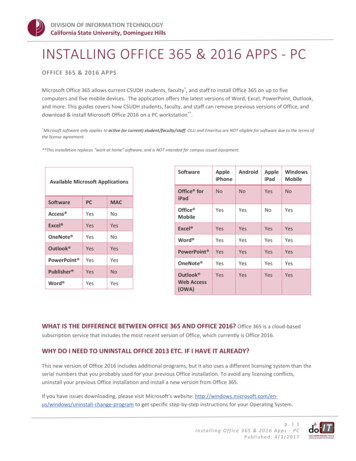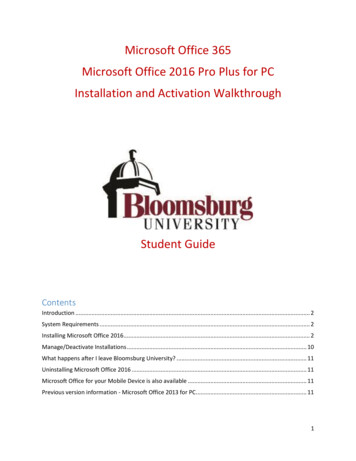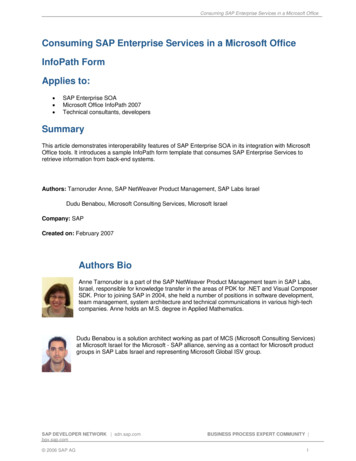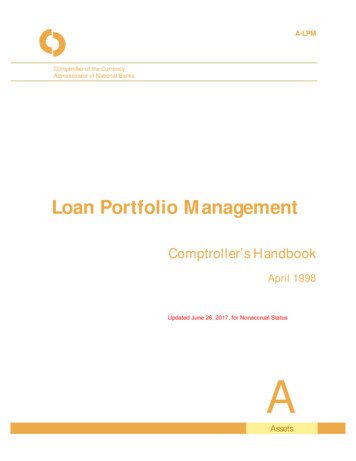
Transcription
A-LPMComptroller of the CurrencyAdministrator of National BanksLoan Portfolio ManagementComptroller’s HandbookApril 1998Updated June 26, 2017, for Nonaccrual StatusAAssets
Loan PortfolioManagementTable of ContentsOverview . 1Risks Associated with Lending . 3Credit Culture and Risk Profile . 11Loan Portfolio Objectives. 13Strategic Planning for the Loan Portfolio. 13Financial Goals . 14Risk Tolerance . 15Portfolio Risk and Reward . 15The Loan Policy . 17Loan Policy Topics . 19Loan Approval Process . 20Portfolio Management . 22Oversight . 22Risk Identification . 22Nonaccrual Status . 24Exceptions to Policy, Procedures, and Underwriting Guidelines. 25Documentation Exceptions . 25Policy and Underwriting Exceptions. 26Aggregate Exception Tracking and Reporting . 27Portfolio Segmentation and Risk Diversification . 28Identifying Concentrations of Risk . 28Evaluating and Managing Concentrations of Risk . 30Concentration Management Techniques . 31Stress Testing . 32Allowance for Loan and Lease Losses . 33Credit Management Information Systems . 34Collections and Work-out . 35Lending Control Functions . 37Independence . 37Credit Policy Administration . 38Loan Review . 38Audit . 39Administrative and Documentation Controls . 39Loan Portfolio ManagementiComptroller’s Handbook
Communication with Senior Management and the Board . 40Loan Portfolio Management Supervision . 41Asset Quality Reviews. 41Targeted Reviews . 42Process Reviews . 42Administrative and Documentation Reviews . 43Compliance Reviews. 43Follow-up Evaluations on Management Commitments . 43Ongoing Supervision . 43Examination Procedures . 45General Procedures . 45Quantity of Risk . 48Quality of Risk Management . 54Conclusion Procedures . 70Appendixes . 72Topics of Loan Policy . 7212 CFR 30 — Safety and Soundness Standards . 78Portfolio Credit Risk Management Processes . 80Loan Production Offices . 85Loan Participations. 87Loan Brokerage and Servicing Activities . 92IRS Express Determination Letters . 93References. 97Loan Portfolio ManagementiiComptroller’s Handbook
Loan PortfolioManagementIntroductionOverviewLending is the principal business activity for most commercial banks. Theloan portfolio is typically the largest asset and the predominate source ofrevenue. As such, it is one of the greatest sources of risk to a bank’s safetyand soundness. Whether due to lax credit standards, poor portfolio riskmanagement, or weakness in the economy, loan portfolio problems havehistorically been the major cause of bank losses and failures.Effective management of the loan portfolio and the credit function isfundamental to a bank’s safety and soundness. Loan portfolio management(LPM) is the process by which risks that are inherent in the credit process aremanaged and controlled. Because review of the LPM process is so important,it is a primary supervisory activity. Assessing LPM involves evaluating thesteps bank management takes to identify and control risk throughout thecredit process. The assessment focuses on what management does to identifyissues before they become problems. This booklet, written for the benefit ofboth examiners and bankers, discusses the elements of an effective LPMprocess. It emphasizes that the identification and management of risk amonggroups of loans may be at least as important as the risk inherent in individualloans.For decades, good loan portfolio managers have concentrated most of theireffort on prudently approving loans and carefully monitoring loanperformance. Although these activities continue to be mainstays of loanportfolio management, analysis of past credit problems, such as thoseassociated with oil and gas lending, agricultural lending, and commercial realestate lending in the 1980s, has made it clear that portfolio managers shoulddo more. Traditional practices rely too much on trailing indicators of creditquality such as delinquency, nonaccrual, and risk rating trends. Banks havefound that these indicators do not provide sufficient lead time for correctiveaction when there is a systemic increase in risk.Loan Portfolio Management1Comptroller’s Handbook
Effective loan portfolio management begins with oversight of the risk inindividual loans. Prudent risk selection is vital to maintaining favorable loanquality. Therefore, the historical emphasis on controlling the quality ofindividual loan approvals and managing the performance of loans continuesto be essential. But better technology and information systems have openedthe door to better management methods. A portfolio manager can nowobtain early indications of increasing risk by taking a more comprehensiveview of the loan portfolio.To manage their portfolios, bankers must understand not only the risk posedby each credit but also how the risks of individual loans and portfolios areinterrelated. These interrelationships can multiply risk many times beyondwhat it would be if the risks were not related. Until recently, few banks usedmodern portfolio management concepts to control credit risk. Now, manybanks view the loan portfolio in its segments and as a whole and considerthe relationships among portfolio segments as well as among loans. Thesepractices provide management with a more complete picture of the bank’scredit risk profile and with more tools to analyze and control the risk.In 1997, the OCC’s Advisory Letter 97-3 encouraged banks to view riskmanagement in terms of the entire loan portfolio. This letter identified nineelements that should be part of a loan portfolio management process. Theseelements complement such other fundamental credit risk managementprinciples as sound underwriting, comprehensive financial analysis, adequateappraisal techniques and loan documentation practices, and sound internalcontrols. The nine elements are: Assessment of the credit culture,Portfolio objectives and risk tolerance limits,Management information systems,Portfolio segmentation and risk diversification objectives,Analysis of loans originated by other lenders,Aggregate policy and underwriting exception systems,Stress testing portfolios,Independent and effective control functions,Analysis of portfolio risk/reward tradeoffs.Loan Portfolio Management2Comptroller’s Handbook
Each of these elements is important to effective portfolio management. To agreater or lesser degree, each indicates the importance of theinterrelationships among loans within the portfolio. Their focus is not onindividual transactions, but on a group of similar transactions and onverifying the integrity of the process. Each practice, by itself, adds adimension to loan portfolio management, but their value is amplified whenthey are used together; moreover, the absence of any one of these elementswill diminish the effectiveness of the others. These elements are described ingreater detail in appendix C and throughout the introductory section of thisbooklet.All banks need to have basic loan portfolio management principles in placein some form. However, the need to formalize the various elementsdiscussed in this booklet, and the sophistication of the process, will dependon the size of the bank, the complexity of its portfolio, and the types ofcredit risks it has assumed. For example, a community bank may be able toimplement these principles in a less formal, less structured manner than alarge bank and still have an effective loan portfolio management process. Buteven if the process is less formal, the risks to the loan portfolio discussed inthis booklet should be addressed by all banks.The examiner assigned LPM is responsible for determining whether the bankhas an effective loan portfolio management process. This includesdetermining whether the risks associated with the bank’s lending activitiesare accurately identified and appropriately communicated to seniormanagement and the board of directors, and, when necessary, whetherappropriate corrective action is taken.This booklet contains important background information on loan portfoliomanagement that examiners should review before conducting an assetquality examination. The risks unique to specific types of loans are addressedin several separate handbook booklets (e.g., “Commercial Real Estate andConstruction Lending,” “Lease Financing,” and “Credit Card Lending”).Risks Associated with LendingAccording to the OCC’s supervision by risk philosophy, risk is the potentialthat events, expected or unexpected, may have an adverse impact on theLoan Portfolio Management3Comptroller’s Handbook
bank’s earnings or capital. The OCC has defined nine categories of risk forbank supervision purposes. These risks, which are defined in otherComptroller’s Handbook sections, are credit, interest rate, liquidity, price,foreign exchange, transaction, compliance, strategic, and reputation. Bankswith international operations are also subject to country risk and transfer risk.These risks are not mutually exclusive; any product or service may expose thebank to multiple risks. For analysis and discussion, however, the OCCidentifies and assesses the risks separately.A key challenge in managing risk is understanding the interrelationships ofthe nine risk factors. Often, risks will be either positively or negativelycorrelated to one another. Actions or events will affect correlated riskssimilarly. For example, reducing the level of problem assets should reducenot only credit risk but also liquidity and reputation risk. When two risks arenegatively correlated, reducing one type of risk may increase the other. Forexample, a bank may reduce overall credit risk by expanding its holdings ofone- to four-family residential mortgages instead of commercial loans, onlyto see its interest rate risk soar because of the interest rate sensitivity andoptionality of the mortgages.Lending can expose a bank’s earnings and capital to all of the risks.Therefore, it is important that the examiner assigned LPM understands all therisks embedded in the loan portfolio and their potential impact on theinstitution. How each of these categories relates to a bank’s lending functionis detailed in the following sections.Credit RiskFor most banks, loans are the largest and most obvious source of credit risk.However, there are other pockets of credit risk both on and off the balancesheet, such as the investment portfolio, overdrafts, and letters of credit. Manyproducts, activities, and services, such as derivatives, foreign exchange, andcash management services, also expose a bank to credit risk.The risk of repayment, i.e., the possibility that an obligor will fail to performas agreed, is either lessened or increased by a bank’s credit risk managementpractices. A bank’s first defense against excessive credit risk is the initialcredit-granting process sound underwriting standards, an efficient, balancedLoan Portfolio Management4Comptroller’s Handbook
approval process, and a competent lending staff. Because a bank cannoteasily overcome borrowers with questionable capacity or character, thesefactors exert a strong influence on credit quality. Borrowers whose financialperformance is poor or marginal, or whose repayment ability is dependentupon unproven projections can quickly become impaired by personal orexternal economic stress. Management of credit risk, however, must continueafter a loan has been made, for sound initial credit decisions can beundermined by improper loan structuring or inadequate monitoring.Traditionally, banks have focused on oversight of individual loans inmanaging their overall credit risk. While this focus is important, banksshould also view credit risk management in terms of portfolio segments andthe entire portfolio. The focus on managing individual credit risk did notavert the credit crises of the 1980s. However, had the portfolio approach torisk management augmented these traditional risk management practices,banks might have at least reduced their losses.Effective management of the loan portfolio’s credit risk requires that the boardand management understand and control the bank’s risk profile and its creditculture. To accomplish this, they must have a thorough knowledge of theportfolio’s composition and its inherent risks. They must understand theportfolio’s product mix, industry and geographic concentrations, average riskratings, and other aggregate characteristics. They must be sure that thepolicies, processes, and practices implemented to control the risks ofindividual loans and portfolio segments are sound and that lending personneladhere to them.Banks engaged in international lending face country risks that domesticlenders do not. Country risk encompasses all of the uncertainties arisingfrom a nation’s economic, social, and political conditions that may affect thepayment of foreigners’ debt and equity investments. Country risk includesthe possibility of political and social upheaval, nationalization andexpropriation of assets, governmental repudiation of external indebtedness,exchange controls, and currency devaluation or depreciation. Unless anation repudiates its external debt, these developments might not make aloan uncollectible. However, even a delay in collection could weaken thelending bank.Loan Portfolio Management5Comptroller’s Handbook
Transfer risk, which is a narrower form of country risk, is the possibility thatan obligor will not be able to pay because the currency of payment isunavailable. This unavailability may be a matter of government policy. Forexample, although an individual borrower may be very successful and havesufficient local currency cash flow to pay its foreign (e.g., U.S. dollar) debt,the borrower’s country may not have sufficient U.S. dollars available topermit repayment of the foreign indebtedness. The transfer risk associatedwith banks’ exposures in foreign countries is evaluated by the InteragencyCountry Exposure Review Committee (ICERC). For examination purposes,the transfer risk rating assigned to a country by the ICERC applies to all bankassets in that country. However, examiners may classify individual loans andother assets more severely for credit risk reasons.Strategies for managing country risk will be discussed in “Country RiskManagement,” a separate booklet in the Comptroller’s Handbook.Interest Rate RiskThe level of interest rate risk attributed to the bank’s lending activitiesdepends on the composition of its loan portfolio and the degree to which theterms of its loans (e.g., maturity, rate structure, embedded options) expose thebank’s revenue stream to changes in rates.Pricing and portfolio maturity decisions should be made with an eye tofunding costs and maturities. When significant individual credits or portfoliosegments are especially sensitive to interest rate risk, they should beperiodically stress-tested. If the asset/liability management committee(ALCO), which typically is responsible for managing the bank’s interest raterisk, is to manage all of the bank’s positions, it must have sufficient reports onloan portfolio and pipeline composition and trends. These reports mightinclude a maturing loans report, pipeline report, and rate and repricingreport.Banks frequently shift interest rate risk to their borrowers by structuring loanswith variable interest rates. Borrowers with marginal repayment capacitymay experience financial difficulty if the interest rates on these loansincrease. As part of the risk management process, banks should identifyborrowers whose loans have heightened sensitivity to interest rate changesLoan Portfolio Management6Comptroller’s Handbook
and develop strategies to mitigate the risk. One method is to requirevulnerable borrowers to purchase interest rate protection or otherwise hedgethe risk.The Comptroller’s Handbook booklet “Interest Rate Risk” provides guidanceon interest rate risk management.Liquidity RiskBecause of the size of the loan portfolio, effective management of liquidityrisk requires that there be close ties to, and good information flow from, thelending function. Obviously, loans are a primary use of funds. And whilecontrolling loan growth has always been a large part of liquiditymanagement, historically the loan portfolio has not been viewed as asignificant source of funds for liquidity management. Practices are changing,however. Banks can use the loan portfolio as a source of funds by reducingthe total dollar volume of loans through sales, securitization, and portfoliorun-off.In fact, banks are taking a more active role in managing their loan portfolios.While these activities are often initiated to manage credit risk, they have alsoimproved liquidity. Banks increasingly are originating loans “for sale” orsecuritization. Consumer loans (mortgages, instalment loans, and creditcards) are routinely originated for immediate securitization. Many largerbanks have been expanding their underwriting for the syndicated loanmarket. Additionally, banks are also expanding the packaging and sale ofdistressed credits and otherwise undesirable loans.As part of liquidity planning, a bank’s overall liquidity strategy should includethe identification of those loans or loan portfolio segments that may be easilyconverted to cash. A loan’s liquidity hinges on such characteristics as itsquality, pricing, scheduled maturities, and conformity to market standards forunderwriting. Loans are also a source of liquidity when used as collateral forborrowings. The ease with which a bank can participate or sell loans to otherlenders or investors (and the terms on which the bank can do so) will varywith market conditions, the type of loan, and the quality of loan. Informationprovided for liquidity analysis should include an assessment of thesevariables under various scenarios.Loan Portfolio Management7Comptroller’s Handbook
Liquidity is also affected by the amount of the bank’s commitments to lendand the actual amount that borrowers draw against those commitments. Abank should have systems to track commitments and borrower usage.Knowledge of the types of commitments, deals in the pipeline, normal usagelevels, and historically high usage levels are important in assessing whetheravailable liquidity will be adequate for normal, seasonal, or emergencyneeds. Management information systems should distinguish betweencommitments that the bank is legally obligated to fund and those (guidanceor advisory lines) that it is not.Any analysis of a bank’s ability to reduce or cut existing commitments mustconsider more than its legal obligation to lend. It should also considerreputation risk and the potential for lender-liability actions. The withdrawalor reduction of commitments can have significant ramifications for a bank.From a strategic perspective, any tightening of commitments may adverselyaffect a bank’s ability to maintain or grow a customer base if it is perceived asan unreliable lender in tight credit markets. A bank’s reputation may alsosuffer if it is perceived as unwilling to support community credit needs.Given these ancillary risks, bank management must carefully assessthe implications of curtailing lending lines.Price RiskMost of the developments that improve the loan portfolio’s liquidity haveimplications for price risk. Traditionally, the lending activities of most bankswere not affected by price risk. Because loans were customarily held tomaturity, accounting doctrine required book value accounting treatment.However, as banks develop more active portfolio management practices andthe market for loans expands and deepens, loan portfolios will becomeincreasingly sensitive to price risk.Loans originated for sale as part of a securitization or for direct placement inthe secondary market carry price risk while they are in the pipeline awaitingpackaging and sale. During that period, the assets should be placed in a“held-for-sale” account, where they must be repriced at the lower of cost ormarket. The same accounting treatment can apply to syndicated credits anddistressed loans. When a bank underwrites a larger portion of a syndicatedLoan Portfolio Management8Comptroller’s Handbook
loan than its “hold” position, the excess portion must be placed in a held-forsale account. Once a sale strategy is adopted for distressed or otherwiseundesirable credits, those credits should also be placed in a held-for-saleaccount.Banks engaged in international lending may be affected by price changes inthe secondary market for such loans. Each month, banks that actively tradeforeign debt must mark to market the loans in their trading account. Inaddition, banks that have elected to hold so-called “Brady Bonds” as loansmust mark them to market in accordance with the requirements of FAS 115.Foreign Exchange RiskForeign exchange risk is present when a loan or portfolio of loans isdenominated in a foreign currency or is funded by borrowings in anothercurrency. In some cases, banks will enter into multi-currency creditcommitments that permit borrowers to select the currency they prefer to usein each rollover period. Foreign exchange risk can be intensified bypolitical, social, or economic developments. The consequences can beunfavorable if one of the currencies involved becomes subject to stringentexchange controls or is subject to wide exchange-rate fluctuations. Foreignexchange risk is discussed in more detail in “Foreign Exchange,” a section ofthe Comptroller’s Handbook.Transaction RiskIn the lending area, transaction risk is present primarily in the loandisbursement and credit administration processes. The level of transactionrisk depends on the adequacy of information systems and controls, thequality of operating procedures, and the capability and integrity ofemployees. Significant losses in loan and lease portfolios have resulted frominadequate information systems, procedures, and controls. For example,banks have incurred increased credit risk when information systems failed toprovide adequate information to identify concentrations, expired facilities, orstale financial statements. At times, banks have incurred losses because theyfailed to perfect or renew collateral liens; to obtain proper signatures on loandocuments; or to disburse loan proceeds as required by the loan documents.Loan Portfolio Management9Comptroller’s Handbook
Compliance RiskLending activities encompass a broad range of compliance responsibilitiesand risks. By law, a bank must observe limits on its loans to a singleborrower, to insiders, and to affiliates; limits on interest rates; and the array ofconsumer protection and Community Reinvestment Act regulations. A bank’slending activities may expose it to liability for the cleanup of environmentalhazards. A bank may also become the subject of borrower-initiated “lenderliability” lawsuits for damages attributed to its lending or collection practices.Supervisory activities should include the review of the bank’s internalcompliance process to ensure that examiners identify and investigatecompliance issues.Strategic RiskA primary objective of loan portfolio management is to control the strategicrisk associated with a bank’s lending activities. Inappropriate strategic ortactical decisions about underwriting standards, loan portfolio growth, newloan products, or geographic and demographic markets can compromise abank’s future. Examiners should be particularly attentive to new business andproduct ventures. These ventures require significant planning and carefuloversight to ensure the risks are appropriately identified and managed. Forexample, many banks are extending their consumer loan activities to “subprime” borrowers. The product may be familiar, but the borrowers’ behaviormay differ considerably from the banks’ typical customer. Do theyunderstand the unique risks associated with this market, can they price for theincreased risk, and do they have the technology and MIS to service thismarket? Moreover, how will they compete with the nonbank companieswho dominate this market? Both bankers and examiners need to decidewhether the opportunities outweigh the strategic risks. If a bank isconsidering growing a loan product or business in a market saturated withthat product or business, it should make sure that it is not overlooking otherlending opportunities with more promise. During their evaluation of the loanportfolio management process, examiners should ensure that bankers arerealistically assessing strategic risk.Loan Portfolio Management10Comptroller’s Handbook
Reputation RiskWhen a bank experiences credit problems, its reputation with investors,the community, and even individual customers usually suffers. Inefficientloan delivery systems, failure to adequately meet the credit needs of thecommunity, and lender-liability lawsuits are also examples of how a bank’sreputation can be tarnished because of problems within its lendingdivision.Reputation risk can damage a bank’s business in many ways. The value of thebank’s stock falls, customers and community support is lost, and businessopportunities evaporate. To protect their reputations, banks often feel thatthey must do more than is legally required. For example, some banks haverepurchased loan participations when credit problems develop, even thoughthese problems were not apparent at the time of the underwriting.Credit Culture and Risk ProfileUnderstanding the credit culture and the risk profile of the bank is central tosuccessful loan portfolio management. Because of the significance of abank’s lending activities, the influence of the credit culture frequentlyextends to other bank activities. Staff members throughout the bank shouldunderstand the bank’s credit culture and risk profile. The knowledge shouldpass from the chief credit policy officer to account officers to administrativesupport. Directors and senior management should not only publicly endorsethe credit standards that are a credit culture’s backbone but should alsoemploy them when formulating strategic plans and overseeing portfoliomanagement.A bank’s credit culture is the sum of its credit values, beliefs, and behaviors.It is what is done and how it is accomplished. The credit culture exerts astrong influence on a bank’s lending and credit risk management. Values andbehaviors that are rewarded become the standards and will take precedenceover written policies and procedures.A bank’s risk profile is more measurable than its credit culture. A risk profiledescribes the various levels and types of risk in the portfolio. The profileevolves from the credit culture, strategic planning, and the day-to-dayactivities of making and collecting loan
credit risk profile and with more tools to analyze and control the risk. In 1997, the OCC’s Advisory Letter 97-3 encouraged banks to view risk managemen





